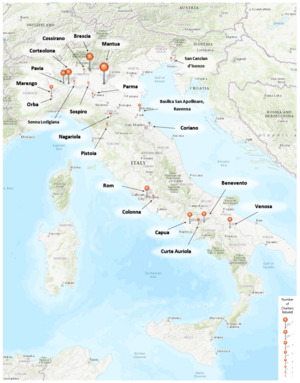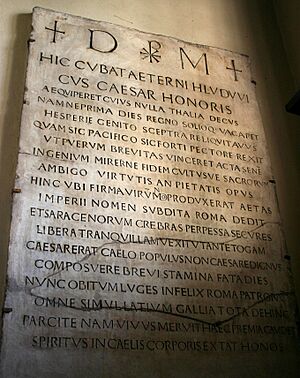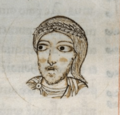Louis II of Italy facts for kids
Quick facts for kids Louis II of Italy |
|
|---|---|
| Emperor of the Romans | |
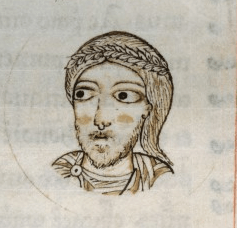
Louis as shown in a 12th-century manuscript of Johannes Berardi's Chronicon casauriense
|
|
| Emperor of the Carolingian Empire | |
| Reign | 844-855 (joint with Lothar I); 855-875 (alone) |
| Predecessor | Lothair I |
| Successor | Charles the Bald |
| Born | 825 |
| Died | 12 August 875 (aged 49–50) Ghedi, Italy, Carolingian Empire |
| Burial | Basilica of Sant'Ambrogio, Milan |
| Spouse | Engelberga |
| Issue | Ermengard of Italy |
| Dynasty | Carolingian |
| Father | Lothair I |
| Mother | Ermengarde of Tours |
| Religion | Roman Catholicism |
Louis II (born 825 – died August 12, 875) was an important ruler in Europe. He was the king of Italy and also the Holy Roman Emperor. He ruled alongside his father, Lothair I, from 844 to 855. After his father's death, Louis ruled alone until 875.
Louis often used the title imperator augustus, which means "august emperor." After he conquered the city of Bari in 871, he started using imperator Romanorum, meaning "emperor of the Romans." This caused some tension with the Byzantine Empire, which was the Eastern Roman Empire. In West Francia, people called him imperator Italiae ("emperor of Italy"). The Byzantines called him Basileus Phrangias ("king of Francia").
A writer named Andreas of Bergamo said that after Louis died, "a great tribulation came to Italy." This shows how important he was to the region.
Contents
Early Life and Becoming King
Louis was born in 825. He was the oldest son of Lothair I, who was also an emperor, and his wife Ermengarde of Tours. Louis's grandfather was the reigning emperor, Louis the Pious.
We don't know much about Louis's early years. He grew up at his grandfather's court. In 839, his grandfather, Louis the Pious, named him King of Italy. Louis then moved to Italy.
His grandfather died the next year. The empire was divided among his sons: Louis's father, Lothair, and Louis's uncle, Louis the German. In 844, Louis was crowned king and co-emperor with his father, Lothair I. This ceremony took place in Rome and was performed by Pope Sergius II. This tradition of crowning a son as co-emperor was started by Charlemagne and his son Louis the Pious.
Ruling with His Father
After his crowning, Louis II immediately tried to claim special rights as emperor in Rome. However, this claim was rejected. In 850, he was crowned joint emperor again in Rome by Pope Leo IV. Soon after, in 851, he married Engelberga. He then began to govern Italy on his own.
In the year of his imperial coronation, Louis marched into southern Italy. He forced two rival dukes of Benevento, Radelchis I and Siconulf, to make peace. His actions divided the Lombard duchy. Radelchis received his share with Benevento as his capital. Salerno was given to Siconulf as an independent area. Radelchis no longer needed his Saracen soldiers. He gladly handed them over to the emperor. Louis then attacked and defeated these Saracen mercenaries.
Louis also settled some issues involving Pope Leo. He held a meeting, called a Diet, in Pavia. In 853, he confirmed Peter of Salerno as the prince of Salerno. When his father died in September 855, Louis became the sole emperor.
Ruling Alone
Dealing with Family and the Church
When his father's lands were divided, Louis did not receive any territory outside Italy. This made him unhappy. In 857, he teamed up with Louis the German against his own brother Lothair II and King Charles the Bald.
However, after Louis helped elect Pope Nicholas I in 858, he made peace with his brother Lothair. In return for helping Lothair try to divorce his wife, Teutberga, Louis received some lands south of the Jura Mountains.
In 863, Louis's brother Charles died. Louis then gained the kingdom of Provence. In 864, Louis had a disagreement with Pope Nicholas I over his brother's divorce. Some archbishops, who had been removed by the Pope for supporting the marriage, got the emperor's help. Louis arrived in Rome with an army in February 864. But he became ill with a fever. He then made peace with the Pope and left the city.
Fighting the Saracens in Bari
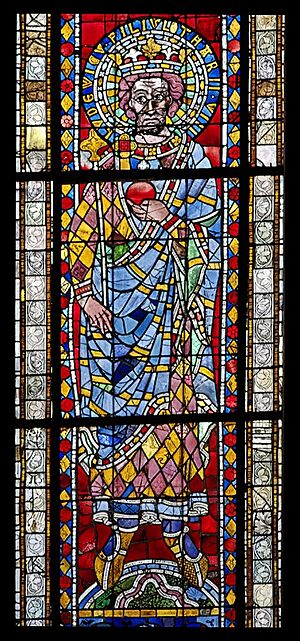
Louis worked hard to bring order to Italy. He was very successful against both the local princes and the Saracens. The Saracens were raiding southern Italy. In 866, Louis asked for help to fight them. He defeated these invaders. However, he couldn't continue his success because he didn't have a navy.
So, in 869, he made an alliance with the Eastern Roman Emperor, Basil I. Basil sent ships to help capture Bari, which was the capital of the Emirate of Bari. Bari fell in 871.
Meanwhile, his brother Lothair had died in 869. Because Louis was busy in southern Italy, he couldn't stop Lotharingia from being divided between Louis the German and Charles the Bald. After the victory at Bari, Louis and Basil had some disagreements. In response to an insult from the Eastern emperor, Louis tried to defend his right to be called "emperor of the Romans."
Trouble in Benevento and Final Years
Louis went to Benevento to get ready for another military campaign. But in August 871, he was attacked in his palace. Adelchis, the prince of Benevento, betrayed him. Louis was robbed and imprisoned. A poem from that time, the Rythmus de captivitate Ludovici imperatoris, describes how sad people were about Louis's capture.
New groups of Saracens landed, which forced Adelchis to release Louis a month later. Louis had to promise he would not seek revenge or enter Benevento with an army again. He returned to Rome. There, he was released from his oath. He was crowned emperor a second time by Pope Adrian II on May 18, 872.
Louis then had more victories against the Saracens. He helped lift the siege of Salerno and drove them out of Capua. However, his attempts to punish Adelchis were not very successful. Louis returned to northern Italy. He died near Ghedi, in what is now the province of Brescia, on August 12, 875. He named his cousin Carloman, son of Louis the German, as his successor in Italy. Louis was buried in the Basilica of Sant'Ambrogio in Milan.
Family
On October 5, 851, Louis married Engelberga, who was the daughter of Adelchis I of Spoleto. They had two daughters:
- Gisela (born between 852 and 855 – died before April 28, 868). She became the Abbess of the Monastery of San Salvador of Brescia in 861.
- Ermengard of Italy. She married Boso of Provence and had children with him.
Images for kids
-
13th-century stained glass depiction of Louis II, Strasbourg Cathedral.
See also
 In Spanish: Luis II el Joven para niños
In Spanish: Luis II el Joven para niños


